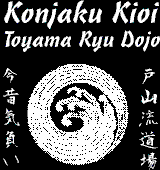|
Home
Hataya
Sensei DVD
Search
Bushido
Respect for Katana
Sword Dictionary
How to Guides
Bow In Ceremony
Warm Up Exercises
Bow Out Ceremony
Wearing Uniform
Formal Uniform
Wearing Daisho
Uniform Folding/Care
Katana Selection
Sword Dimensions
Sword Testing
Katana Maintenance
Katana Cleaning
Mekugi Replacement
Katana Disassembly
Is my sword sharp?
Edge Geometry
Surface Polish
Sharpening Guide
Training Basics
Kihon (Fundamentals)
8 Basic Cuts
Toyama Kata
Toyama Kukmitachi
Seitei Kata
Taikai Guides
Taikai Rules
Judging Guide
Tameshigiri
Target Prep & Spiking
Cutting Patters
Cutting Videos
Target Comparison
St Petersburg Dojo
Intro Letter
Femal Sensei
Dojo Members
Code of Conduct
Classes and Fees
Promotion Pictues
Rank Testing
Links

|
Katana Maintenance Information
This section covers various pages discussing maintenance of the Japanese Katana. If
you have any questions just email me at
info@toyama-ryu.com and we will be glad to discuss any topic. The dojo
store offers full
sharpening, repair,
and customization
services to keep your katana in top working order.
The Konjaku Kioi Toyama Ryu Dojo, its employees, and
associated companies are not responsibility for an injury, damage or loss
incurred by following any advice given on this site. Katana are dangerous
objects and the utmost care should be given when working with them.
- Sword Cleaning: Katana must be cleaned immediately after tameshigiri and at the end
of class. Unlike most decorative wall hangers - real katana rust! If
the blade is touched - it needs to be immediately cleaned unless you want to
personalize your blade with rust fingerprints.
- Mekugi Replacement: A traditional
nihonto (Japanese made sword) is held together with a single small
bamboo peg called a mekugi. They are not riveted, glued, or
screwed together. A samurai staked his life on that one small peg.
Two or three poorly done mekugi are not as good as a single properly
done one. Special
classes are offered in the dojo that cover this topic.
- Katana Disassembly: A proper
katana can be disassembled for inspection, repair, or a thorough
cleaning. It is also fairly easy to customize you katana by
swapping tsuba. This guide will walk you through the steps of
disassembling your katana.
- Is my sword sharp?: This section discusses what makes a sword dull and how you can test the edge.
A sword can feel sharp and still not cut. A good katana should
keep an edge for about 6 months of moderate use.
- Edge Geometry: This section discusses proper and improper edge geometry for tameshigiri.
How the cutting planes of the katana affect how it cuts through targets
and what edges are good for different types of targets.
- Sharpening Guide: This section has step by step instructions on how to sharpen your own sword
using Japanese Water Stones. Special classes are offered in the
dojo that cover this topic.
-
Sharpening Service: Don't want to try sharpening your own sword? Find out how you can
have your martial art katana sharpened for a reasonable rate. This
link goes to the Nihonzashi web site.
|

